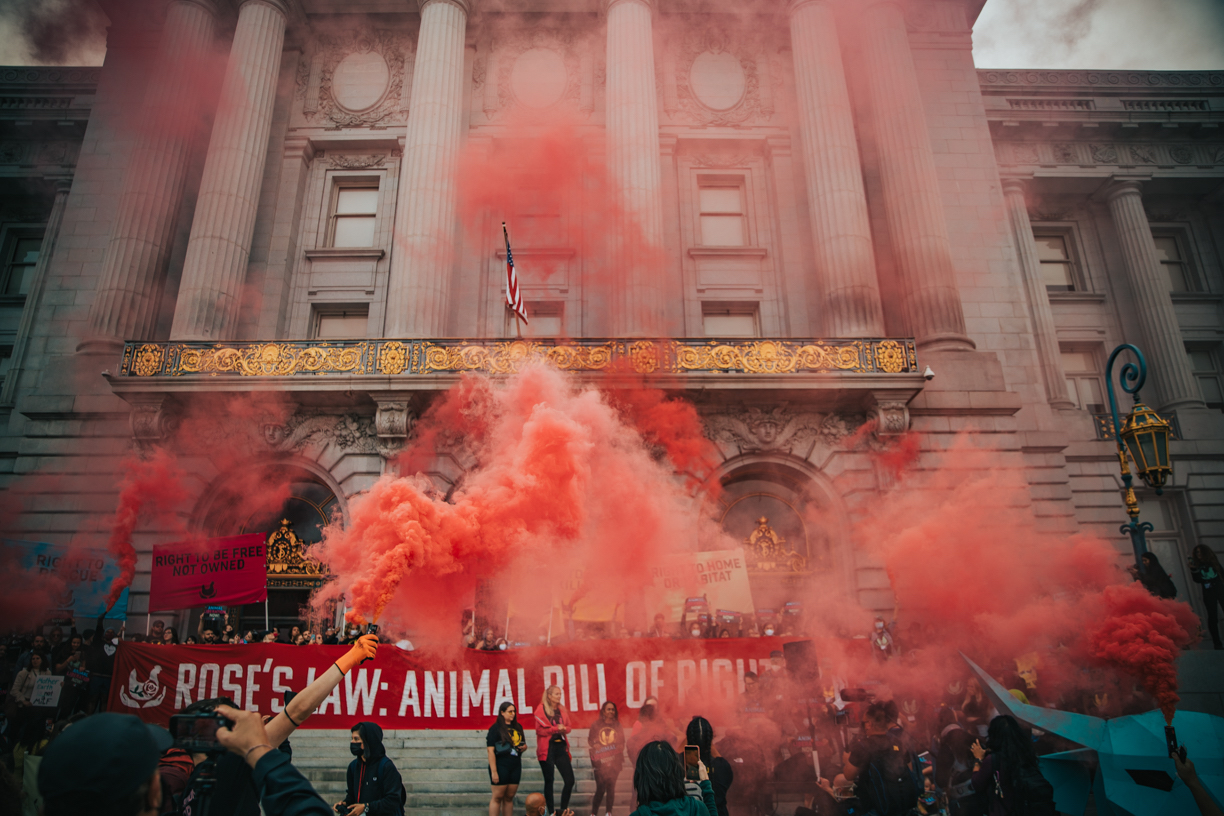On the Importance of Protest

A remarkable protest -- Earthlings: No Longer Blind to Injustice -- is being organized by a coalition of activists and groups in Israel, including the unaffiliated activist and scholar Asaf Harduf and my friend Sasha Boojor at 269life. DxE is delighted and honored to play a small role, in organizing the solidarity demonstrations in the United States. (And we ask that all of you do the same!)
And yet, though thousands are expected on the streets of Tel Aviv, and at least hundreds more in the United States, a nagging question remains:
Are we really making a difference? Don't people just dismiss animal rights protesters as "crazies"?
After all, the movement for animal liberation, it is often said, faces a much more difficult struggle than previous social justice movements. As a numerical matter, there are far more individual lives at stake than in any past system of human exploitation. And 98% of the U.S. population regularly consumes the flesh of our non-human friends. Committed allies to the cause of animal rights, in contrast, are few and far between. While hundreds of thousands march at an anti-war protest, the largest animal rights events are lucky to draw a few hundred.
In the face of these gloomy facts, it is easy to feel hopeless. "I'm so small," we tell ourselves. "And the problem is so big." And when we tell ourselves such things, it is easy to give up.
But how does our situation compare to the situations faced, for example, by civil rights activists in 1955, or antislavery activists in 1831?
Some perspective is useful. First, while the scale of violence and oppression by modern animal industries is indeed unprecedented in history, the comparative importance of animal exploitation to our society is, in fact, small. Animal agriculture, even by industry measures, comprises less than 1% of the American economy. And animal liberation does not demand a fundamental restructuring of human social relations. In contrast, in the antebellum period, slavery was the core of the Southern economy. And in the Jim Crow period, segregation and racism animated all aspects of American society. The changes demanded by the animal rights movement, in other words, are in fact small when compared with those demanded by other social justice movements in recent history.
Second, what of the state of public sympathy? Consider a prominent civil rights scholar's account of the world facing a civil rights activist in 1955:
Imagine a rational analyst in mid-1955 evaluating the situation for African Americans in the South. The "logical" conclusion would be that there was very little Black people themselves could do to change their oppressive conditions. Blacks were relegated to the bottom of the economic order and most were disenfranchised. White office holders were overwhelmingly hostile locally, and national advocates of Black rights were an ineffective minority. In Southern courts, white testimony would be accepted over Black regardless of the actual facts of the case. Except for a small but significant Black press, white proponents of continued Black subordination controlled the media. White supremacist groups including the Ku Klux Klan and the White Citizens Council operated freely, while members of groups advocating racial equality like the NAACP faced severe repression.
Day-to-day oppressive life circumstances forced African Americans to abide by a variety of humiliating conditions. Segregation – in schools, bathrooms, waiting areas, water fountains – separated Blacks and whites, causing Blacks to experience a lower quality of life, and to be flooded with messages of inferiority. Even minor "transgressions" of the segregated order might be punished immediately and severely, leaving little space for resistance. Most Black people were unwilling to fight the system openly, and many de facto accepted the label of "inferior." Perhaps a legal strategy of change could be attempted, but the 1954 Supreme Court decision in Brown vs. Topeka Board of Education had led to increased repression rather than to integration. And yet: just a decade later a mass movement had transformed America, both Black and white consciousness were forever altered, and landmark legal changes had passed Congress.
What this excerpt shows us is that the notion that civil rights activists had it easy -- that there were many people willing to stand up for minority rights, or that the public was sympathetic to their message -- is simply wrong. Under Jim Crow, the smallest acts of resistance would often lead to violent retribution. And civil rights leaders whom we lionize today were in fact considered dangerous extremists in their day. Martin Luther King, Jr., for example, was described in an internal FBI memo as "the most dangerous… Negro leader in the country." Moderate white "supporters" of civil rights decried King (an advocate of law-breaking and direct action) as an inciter of hate. King's famous "Letter from a Birmingham Jail" was a response to one such attack; and in that letter, he suggests that meekly supportive moderates -- not racists -- might be the "great stumbling block in stride toward freedom."
Similarly, the four student activists who performed the first sit-in against segregation in Greensboro, NC, including a now-forgotten man named David Richmond, were met with ridicule and disbelief, even in the black community. When they began their protest, the black waitress at the counter said to them, "Fellows like you make our race look bad." Within 10 years, of course, tens of thousands of activists were doing the same, and the forces of racial oppression were on the retreat.
We see a similar state of affairs for activists in the antislavery movement. When William Lloyd Garrison broke with the mainstream "antislavery" organization of his time -- the infamously racist American Colonization Society -- he lost many of his white friends, and was decried as an extremist by former allies. He had only 400 mostly-black subscribers to the first issue of his pioneering journal, The Liberator. Despite such trifling support, he proclaimed his intent loudly and clearly in The Liberator's inaugural editorial: "I am aware that many object to the severity of my language; but is there not cause for severity? I do not wish to think, or speak, or write, with moderation... I am in earnest -- I will not equivocate -- I will not excuse -- I will not retreat a single inch -- AND I WILL BE HEARD." Even thirty years later, when a significant mass of the public had been mobilized behind the cause of antislavery, Abraham Lincoln was decried by a prominent Ohio editor as "monstrous, impudent, and heinous" for declaring "equal whom God created unequal."
In short, initial rejection is not unique to the animal rights movement. Indeed, as Gandhi wrote, directly facing ridicule and rejection is a necessary step in any successful challenge to conventional ideologies. The only way to escape public backlash is to back down from any challenge at all.
The moral of the story is that the difficulties facing our movement are not unusual or insurmountable. And when critics say that the problem is too big, or that the public is too hostile, they are not saying anything that has not been said before. Yet in every previous social justice movement, activists were not fazed by such challenges -- far from it, they overcame them, and changed the world for the better.
And who were these brave activists? We prominently remember names such as Garrison and Anthony, Parks and King, when we think of the remarkable progress our society has made. But social movements of the past two centuries have been products of mass mobilization. Rosa Parks, for example, was preceded by many others who had acted out in protest against the Montgomery bus system. And while her predecessors, such as a brave 15-year-old named Claudette Colvin (who refused to give up her seat on a segregated bus, a few months prior to Parks), did not share Parks' individual fame, they were just as instrumental in building the social and political climate from which the Civil Rights Movement was born.
Every act of resistance inspired others to do the same. Every word of dissent made it easier for subsequent dissenters to raise their own voices.
When we say that we are too small, then, we are suffering from an illusion, an illusion that only "great men" hold power, and that ordinary people have no sway. The truth is that it is the ordinary people of the world, the Claudette Colvins and David Richmonds of the Civil Rights Movement, who must act to make the world a better place. And while each of us is part of a much bigger picture, the first few strokes on the tapestry, small as they may be, are the most important ones. We cannot build institutions that resist animal exploitation with vigilance, if we are not vigilant about defending animals ourselves. We cannot end the murder of our fellow Earthlings, if we do not speak out forcefully against those whose hands and teeth are stained with their blood. And we cannot create a world for animal liberation, if we do not live out a vision of animal liberation (with all the tension and confrontation that entails) in our own lives. If we are not willing -- indeed, inspired -- to protest.
So we can now turn our original concern on its head -- yes, the problem is big, but that only makes every one of us even more important to the cause. And yes, each of us individually may feel small, against a hostile public, but if we do not fall victim to hopelessness and cynicism, together we have the numbers and strength to make animal liberation a reality.
Other articles

Tulare County Dairy Farms Are Poisoning Latino Communities

The Case for Systemic Change




